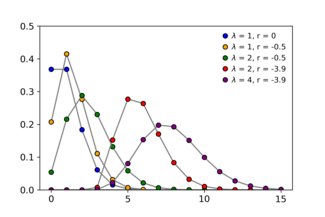Displaced Poisson distribution
|
Probability mass function  Displaced Poisson distributions for several values of [math]\displaystyle{ \lambda }[/math] and [math]\displaystyle{ r }[/math]. At [math]\displaystyle{ r=0 }[/math], the Poisson distribution is recovered. The probability mass function is only defined at integer values. | |||
| Parameters | [math]\displaystyle{ \lambda\in (0, \infty) }[/math], [math]\displaystyle{ r\in (-\infty, \infty) }[/math] | ||
|---|---|---|---|
| Support | [math]\displaystyle{ k \in \mathbb{N}_0 }[/math] | ||
| Mean | [math]\displaystyle{ \lambda - r }[/math] | ||
| Mode | [math]\displaystyle{ \begin{cases} \left\lceil \lambda - r \right\rceil - 1, \left\lfloor \lambda - r \right\rfloor & \text{if } \lambda \geq r+1\\ 0 & \text{if } \lambda \lt r+1\\ \end{cases} }[/math] | ||
| Variance | [math]\displaystyle{ \lambda }[/math] | ||
| MGF |
[math]\displaystyle{ e^{\lambda \left( e^{t-1} \right) - tr } \cdot \dfrac{I \left( r+s, \lambda e^{t} \right)}{I \left( r+s, \lambda \right)} }[/math], [math]\displaystyle{ I \left(r, \lambda \right) = \sum^\infty_{y=r} \dfrac{e^{-\lambda} \lambda^y}{y!} }[/math] When [math]\displaystyle{ r }[/math] is a negative integer, this becomes [math]\displaystyle{ e^{\lambda \left( e^{t-1} \right) - tr } }[/math] | ||
In statistics, the displaced Poisson, also known as the hyper-Poisson distribution, is a generalization of the Poisson distribution.
Definitions
Probability mass function
The probability mass function is
- [math]\displaystyle{ P(X=n) = \begin{cases} e^{-\lambda}\dfrac{\lambda^{n+r}}{\left(n+r\right)!}\cdot\dfrac{1}{I\left(r, \lambda\right)}, \quad n=0,1,2,\ldots &\text{if } r\geq 0\\[10pt] e^{-\lambda}\dfrac{\lambda^{n+r}}{\left(n+r\right)!}\cdot\dfrac{1}{I\left(r+s,\lambda\right)},\quad n=s,s+1,s+2,\ldots &\text{otherwise} \end{cases} }[/math]
where [math]\displaystyle{ \lambda\gt 0 }[/math] and r is a new parameter; the Poisson distribution is recovered at r = 0. Here [math]\displaystyle{ I\left(r,\lambda\right) }[/math] is the Pearson's incomplete gamma function:
- [math]\displaystyle{ I(r,\lambda)=\sum^\infty_{y=r}\frac{e^{-\lambda} \lambda^y}{y!}, }[/math]
where s is the integral part of r. The motivation given by Staff[1] is that the ratio of successive probabilities in the Poisson distribution (that is [math]\displaystyle{ P(X=n)/P(X=n-1) }[/math]) is given by [math]\displaystyle{ \lambda/n }[/math] for [math]\displaystyle{ n\gt 0 }[/math] and the displaced Poisson generalizes this ratio to [math]\displaystyle{ \lambda/\left(n+r\right) }[/math].
Examples
One of the limitations of the Poisson distribution is that it assumes equidispersion – the mean and variance of the variable are equal.[2] The displaced Poisson distribution may be useful to model underdispersed or overdispersed data, such as:
- the distribution of insect populations in crop fields;[3]
- the number of flowers on plants;[1]
- motor vehicle crash counts;[4] and
- word or sentence lengths in writing.[5]
Properties
Descriptive Statistics
- For a displaced Poisson-distributed random variable, the mean is equal to [math]\displaystyle{ \lambda - r }[/math] and the variance is equal to [math]\displaystyle{ \lambda }[/math].
- The mode of a displaced Poisson-distributed random variable are the integer values bounded by [math]\displaystyle{ \lambda - r - 1 }[/math] and [math]\displaystyle{ \lambda - r }[/math] when [math]\displaystyle{ \lambda \geq r+1 }[/math]. When [math]\displaystyle{ \lambda \lt r+1 }[/math], there is a single mode at [math]\displaystyle{ x=0 }[/math].
- The first cumulant [math]\displaystyle{ \kappa_{1} }[/math] is equal to [math]\displaystyle{ \lambda - r }[/math] and all subsequent cumulants [math]\displaystyle{ \kappa_{n}, n \geq 2 }[/math] are equal to [math]\displaystyle{ \lambda }[/math].
References
- ↑ 1.0 1.1 Staff, P. J. (1967). "The displaced Poisson distribution". Journal of the American Statistical Association 62 (318): 643–654. doi:10.1080/01621459.1967.10482938.
- ↑ Chakraborty, Subrata; Ong, S. H. (2017). "Mittag - Leffler function distribution - a new generalization of hyper-Poisson distribution" (in en). Journal of Statistical Distributions and Applications 4 (1). doi:10.1186/s40488-017-0060-9. ISSN 2195-5832.
- ↑ Staff, P. J. (1964). "The Displaced Poisson Distribution" (in en). Australian Journal of Statistics 6 (1): 12–20. doi:10.1111/j.1467-842X.1964.tb00146.x. ISSN 0004-9581. https://onlinelibrary.wiley.com/doi/10.1111/j.1467-842X.1964.tb00146.x.
- ↑ Khazraee, S. Hadi; Sáez‐Castillo, Antonio Jose; Geedipally, Srinivas Reddy; Lord, Dominique (2015). "Application of the Hyper‐Poisson Generalized Linear Model for Analyzing Motor Vehicle Crashes" (in en). Risk Analysis 35 (5): 919–930. doi:10.1111/risa.12296. ISSN 0272-4332. PMID 25385093. Bibcode: 2015RiskA..35..919K. https://onlinelibrary.wiley.com/doi/10.1111/risa.12296.
- ↑ Antić, Gordana; Stadlober, Ernst; Grzybek, Peter; Kelih, Emmerich (2006), Spiliopoulou, Myra; Kruse, Rudolf; Borgelt, Christian et al., eds., "Word Length and Frequency Distributions in Different Text Genres" (in en), From Data and Information Analysis to Knowledge Engineering (Berlin/Heidelberg: Springer-Verlag): pp. 310–317, doi:10.1007/3-540-31314-1_37, ISBN 978-3-540-31313-7, http://link.springer.com/10.1007/3-540-31314-1_37, retrieved 2023-12-07
 |

